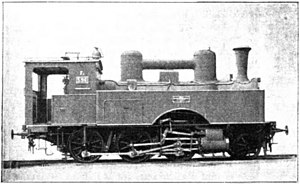Württemberg vehicle
| Württemberg vehicle DR series 97.3 |
|
|---|---|
|
Württemberg vehicle
|
|
| Numbering: | 691-694 591-599 (later) DR 97 301-307 |
| Number: | 9 |
| Manufacturer: | Esslingen |
| Year of construction (s): | 1893-1904 |
| Retirement: | 1930 |
| Type : | 1'C n2 / n4v |
| Genre : | Z 34.14 |
| Gauge : | 1435 mm ( standard gauge ) |
| Length over buffers: | 9,490 mm |
| Fixed wheelbase: | 5,420 mm |
| Empty mass: | 43.0 t |
| Service mass: | 53.3 t |
| Friction mass: | 41.5 t |
| Wheel set mass : | 13.8 t |
| Top speed: | 50 km / h / 20 km / h |
| Driving wheel diameter: | 1,230 mm |
| Impeller diameter front: | 945 mm |
| Gear system : | Riggenbach |
| Cylinder diameter: | 612 mm |
| Piston stroke: | 420 mm |
| Cylinder d. Gear drive: | 420 mm |
| Piston stroke gear drive: | 540 mm |
| Boiler overpressure: | 14 bar |
| Grate area: | 1.40 m² |
| Radiant heating surface: | 7.00 m² |
| Evaporation heating surface: | 112.40 m² |
| Water supply: | 4.2 m³ |
| Fuel supply: | 1.0 t coal |
| Brake: | Westinghouse compressed air brake (installed later), block brake (acting on the friction gears), band brake (acting on the crank disks of the transmission gears), spindle brake and vapor brake with lateral blocks (acting on the rear ring gear), device for Heberlein brake. |
The steam locomotives of the type Fz of the Royal Württemberg State Railways were cogwheel locomotives whose gearwheel drive was designed for driving on rails with the Riggenbach rack and pinion system . Seven machines (Nos. 591 to 596 and 599) were taken over by the Deutsche Reichsbahn and in 1925 classified as class 97.3 in their numbering plan .
The first four copies of the locomotive were named Achalm , Grafeneck , Lichtenstein and Münsingen and were used on the Honau – Lichtenstein cog railway . The five younger specimens drove between Freudenstadt and Klosterreichenbach . In contrast to the first four, these vehicles had a connecting pipe between the two steam domes.
The boiler and drive were taken over by the Württembergische F.
The machines had gears on the first and second axes, which were driven by a small gear in between. The small gear itself was driven by the inner two cylinders of the four-cylinder steam engine. The machines could either be operated as a compound machine with successive superheated steam - wet steam operation or, for higher capacities, as a quad machine with direct boiler steam feed to all cylinders. The control mechanics of the internal steam engine was so complex and prone to failure that the locomotives were decommissioned and scrapped by the Deutsche Reichsbahn by 1930. The boiler also did not meet the requirements. The rack had to be kept on the rack almost regularly when driving up the mountain, as all the steam was used up and more had to be cooked.
swell
- Hans Steffan : New cogwheel locomotives. (End of page 164) In: Die Lokomotive , 1905, pp. 180–181 ( ANNO - AustriaN Newspapers Online )

